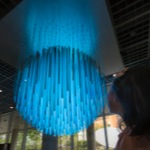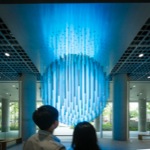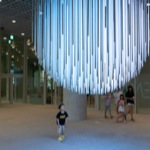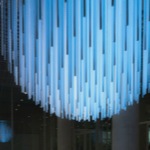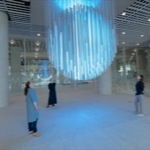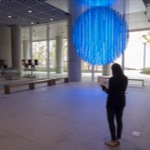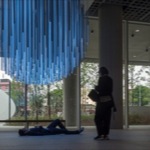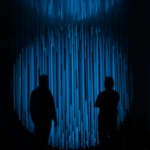Blue Sun
A spherical volumetric display simulates the turbulence, flares, and spots visible on the surface of the sun using the hottest colours in the spectrum: blue and white. The piece is animated by fluid, dynamic mathematical equations—reaction-diffusion, Navier-Stokes, Perlin noise, and fractal flames—combined with the latest imagery from NASA’s Solar Dynamics Observatory (SDO) and Solo and Heliospheric Observatory (SOHO). The content is a live simulation, not a looped video, so it never repeats itself.
Three meters in diameter, the sphere consists of 25,580 LED lights on 342 battens which are arranged according to equations developed by Pierre de Fermat, specifically a spiraling pattern used to describe plant phyllotaxis. In turn, the sphere does not have any vanishing points.
Blue Sun is an iconic chandelier, constantly changing. It equally draws inspiration from the immersive geometric artworks of Latin American artists such as Jesús Rafael Soto, Carlos Cruz-Diez, and Julio Le Parc, and scientists such as Pierre de Fermat, Oleg Losev, and Shuji Nakamura. The blue and white shades represent the true colour temperature of the sun; traditionally, the star is depicted in yellow, orange and red, though this is more of a cultural rendering to appeal to our understanding of fire.
The piece is co-produced by The Amorepacific Museum of Art, Seoul and the Musée National des Beaux-Arts, Quebec.
Three meters in diameter, the sphere consists of 25,580 LED lights on 342 battens which are arranged according to equations developed by Pierre de Fermat, specifically a spiraling pattern used to describe plant phyllotaxis. In turn, the sphere does not have any vanishing points.
Blue Sun is an iconic chandelier, constantly changing. It equally draws inspiration from the immersive geometric artworks of Latin American artists such as Jesús Rafael Soto, Carlos Cruz-Diez, and Julio Le Parc, and scientists such as Pierre de Fermat, Oleg Losev, and Shuji Nakamura. The blue and white shades represent the true colour temperature of the sun; traditionally, the star is depicted in yellow, orange and red, though this is more of a cultural rendering to appeal to our understanding of fire.
The piece is co-produced by The Amorepacific Museum of Art, Seoul and the Musée National des Beaux-Arts, Quebec.
General info
Spanish name:
Sol Azul
Year of creation:
2018
Technique:
LED battens, aluminum and wood framework, computer running solar turbulence equations
Power:
19,2 kW (4 x 20A @ 240V or 4 x 20A @ 208V)
Room conditions:
Must hang with south pole between 220 - 300 cm from the ground. It does not produce sound, nor is it affected by it.
Dimensions:
300 cm diameter
Edition:
3 Editions, 1 AP
Exhibitions
- Rafael Lozano-Hemmer: Decision Forest, Amorepacific Museum of Art, Seoul, South Korea, 2018.
Credits
- Curator: KyoungRan Kim
- Programming: Rodd McLaughlin, Miguel Legault
- 3D Model: Marc Lavallée, Kitae Kim, Zak Haywood
- Production Assistance: Guillaume Tremblay, Jessica Blanchet, Karine Charbonneau, Pipo Pierre Louis, Mirim Lee
- Structural Engineering, Control, and LED vSticks: SACO
- Electrician: Master Choi
- Installation: Dongbu
Photo Library (click to expand)
